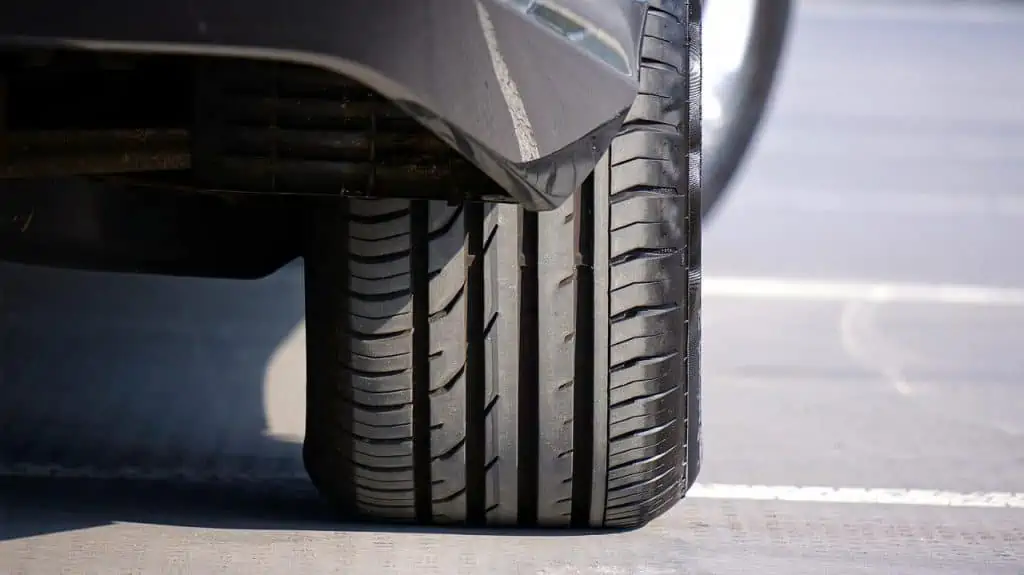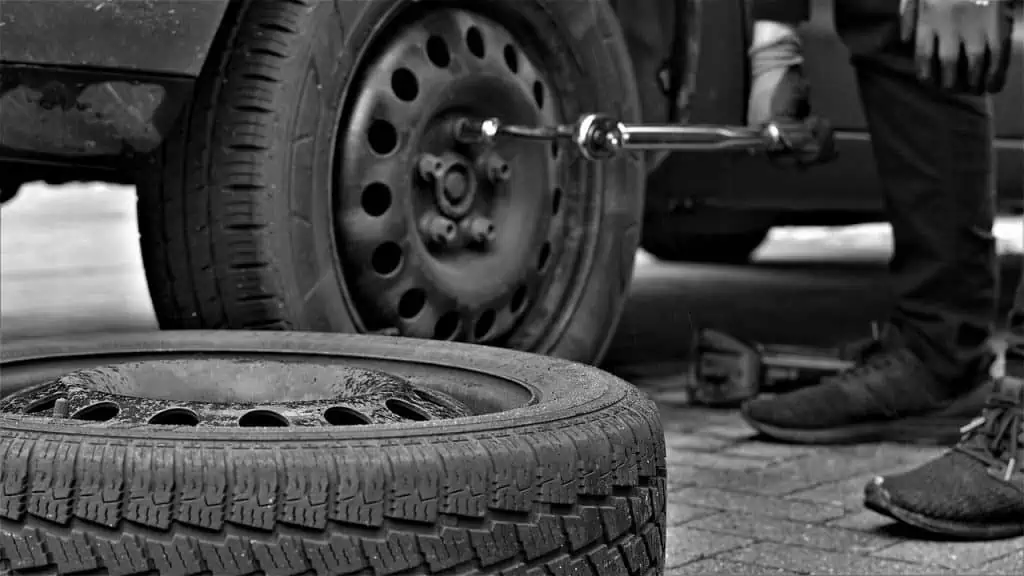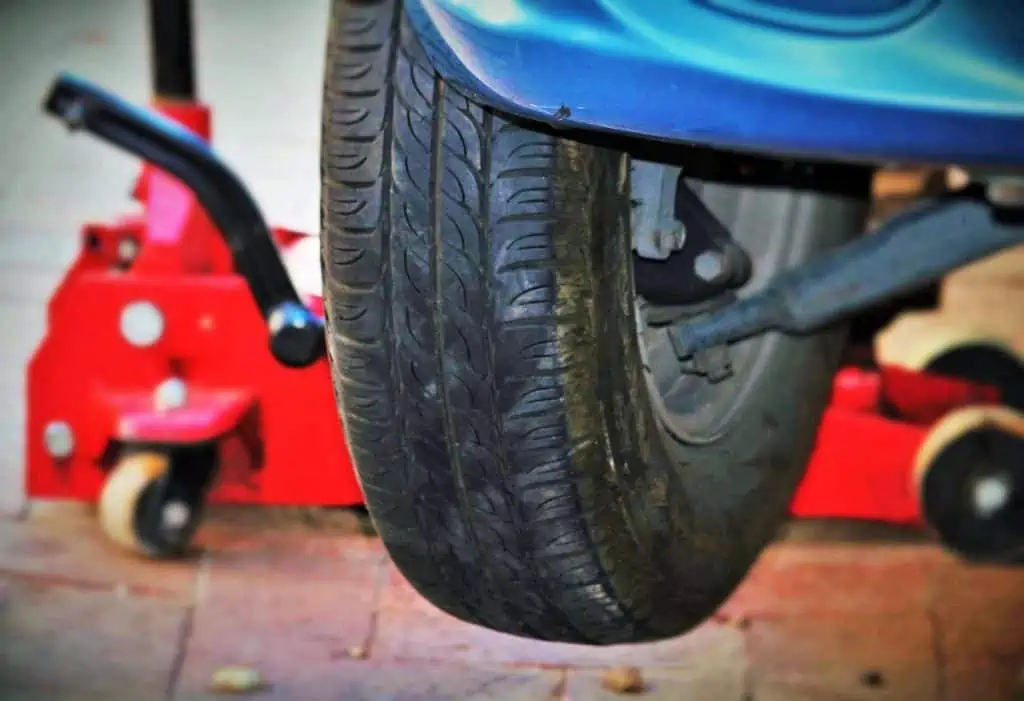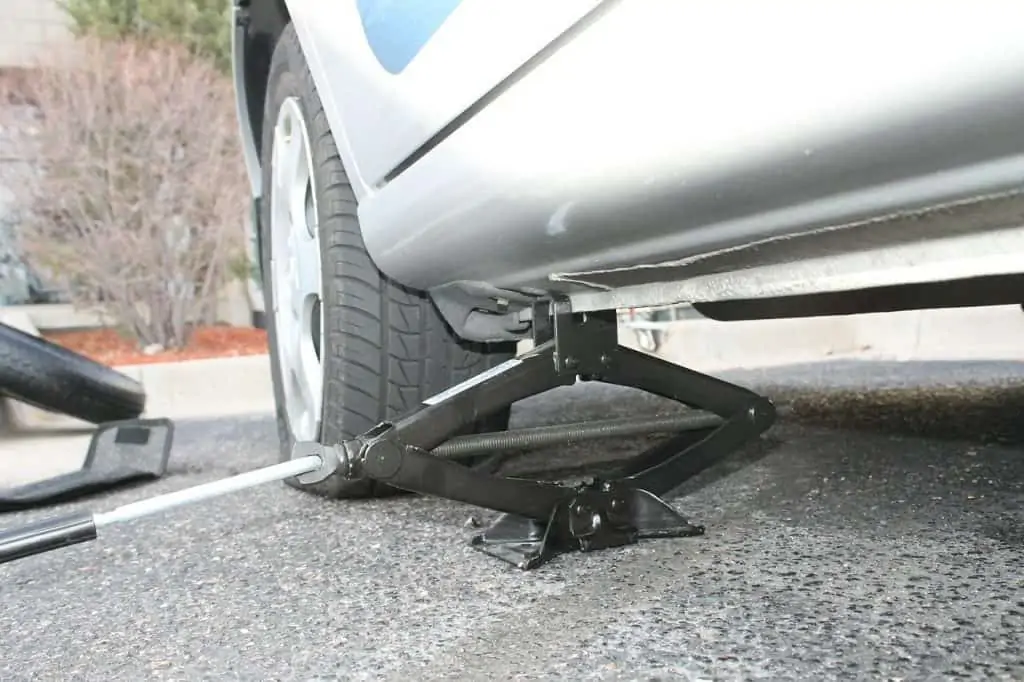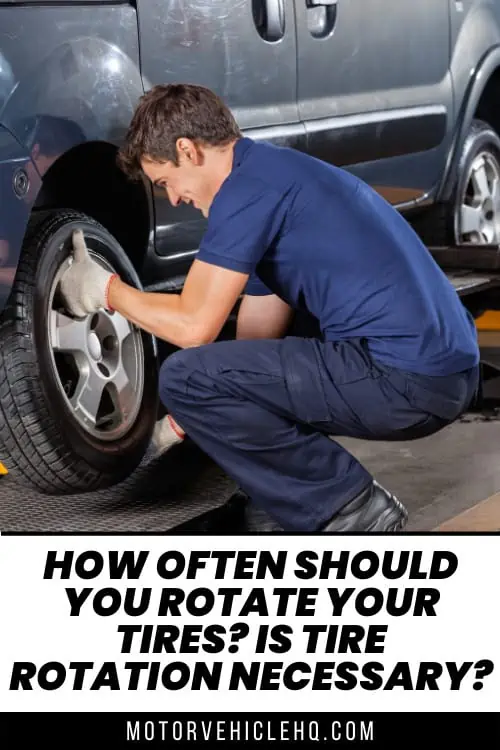You want your car tires to last as long as possible since they are almost always fairly expensive. So that your tires can last considerably longer, you may want to know how often should you rotate your tires. You will probably be able to save money by not always needing to buy tires for your automobile.
Tires that are just worn out on one side require replacement, which is immensely aggravating. You must rotate your tires regularly to prevent it. It’s usually time to move these tires to different locations on the automobile if one side appears to be more worn than the other.
Tire rotation advice varies, ranging from every 3,000 miles to every 8,000 miles. But they are only suggestions. Even if the maker of your tires says you may wait longer, it’s still advisable to check your tires frequently for uneven wear.
Similar to summer tires designed for performance, softer tires typically need to be rotated more frequently than their harsher counterparts.
No matter what sort of vehicle you drive, each corner’s tires perform a somewhat distinct function. They dress differently as a result. Particularly in front-wheel-drive vehicles, the front tires exert substantially more force than the rear tires.
All of the weight associated with turning, accelerating, and braking falls on the front pair. The majority of the weight is likewise carried by the front of front-engine, front-wheel vehicles, increasing the stress on those tires.
Vehicles with rear- or all-wheel drive are not an exception. Any automobile will wear its tires differently simply due to the unique suspension or alignment of that specific vehicle. Therefore, if you can, rotate them.
What Is Tire Rotation, and Why Often Should You Rotate Your Tires?
The most frequently neglected of all preventative maintenance activities may be how regularly to rotate tires. But what is it exactly? Why, therefore, do car makers advise it?
Tire rotation is a technique for controlling tread wear. The grating, scouring, and scraping that occurs on the tread of your tires while your automobile travels over uneven terrain and roadways.
Each tire on your car’s axles is relocated to a new location during a tire rotation. Like switching the front right tire’s location to the rear left. The shuffling promotes more even tire wear.
To determine how frequently you must rotate your tires, see your owner’s handbook or speak with your neighborhood auto repair professionals.
The majority of automakers advise rotating your tires every 3,000 to 8,000 miles, or every six months. This is dependent on how frequently you use your automobile and how much work it does.
Why Is It Important to Often Rotate Your Tires?
You may promote even tread wear by adhering to the manufacturer-recommended tire rotation intervals for your car. This enhances handling, lessens noise and vibration, increases tire life, and safeguards your tire warranty.
These actions not only save you from having new tires more frequently, but they may also improve your driving safety.
One of your car’s most crucial safety components is its tires. They are still the only automotive components that come in contact with the ground, which is why.
Tires should be rotated regularly to assist extend tread life. Additionally, it encourages more consistent tread wear across all tires on a car.
It’s crucial to balance the wear on each of the four tires. This is because it balances the traction between the vehicle’s front and back wheels.
This makes it possible for the car to respond as well as possible to driving scenarios. An unexpected slippery scenario might result in a loss of control if one end of the car has more degraded tires than the other.
Tires may be changed in a set of four if the wear is kept uniform on all four wheels. By doing this, you may ensure that the front and rear handling of the automobile are equal.
Furthermore, tire technology will advance. You may gain from improvements in tire technology by being able to change all four tires at once.
The front tires of some cars, particularly the front-wheel-drive models, frequently wear out more quickly than the rear tires.
This is brought on by the additional weight on the front axle as well as the additional forces needed for steering, braking, and accelerating. To extend the tire’s lifespan on these cars, it’s crucial to rotate the tires.
How Often Should You Rotate Your Tires for Car?
Rotate your tires as often as recommended by the tire manufacturer.
They produced the tires, put them through several tests, and have a sizable customer base that they employ as part of an ongoing research effort to make sure that their suggestions are in the best interests of the client and the business.
They most likely possess the most knowledge! Additionally, if a warranty dispute should later occur, documentation of compliance with manufacturer instructions for routine maintenance may be needed.
As recommended by your mechanic or the owner’s handbook, rotate your tires regularly. At least once a year, you’ll probably bring your car in for standard maintenance like an oil change.
Your technician will examine the tires from all sides and offer professional advice about whether or not they need to be rotated. They could just do it for you without charging you.
Generally speaking, you want to ask to have your tires rotated every six months or every 3000 to 8000 miles you drive your automobile. That is merely a general guideline, though!
Unless you feel under pressure from an overly zealous mechanic, err on the side of the tire manufacturer’s suggestion if your auto repair and you have different opinions.
A quick approach to make sure you’re caring for your tires is to rotate the tires on your automobile. which are the sole area of your automobile that makes contact with the pavement. Making sure that your tires undergo uniform to wear may be achieved by rotating your tires.
As a result, your automobile will remain balanced, endure longer, and operate more safely. You shouldn’t rotate your tires in some circumstances merely because the time isn’t right, though.
Do You Need to Rotate Your Tires Often?
Yes, almost every automobile needs its tires rotated. The single exception is made for vehicles utilizing directional tires that cannot be switched from one side to the other and have staggered tire widths from the front to the back.
The majority of the time, high-performance automobiles will have this exemption.
If I Don’t Rotate My Tires Often, What Happens?
Tire treads can deteriorate unevenly without routine rotation, producing a harsh and dangerously unstable driving surface.
Ultimately, this kind of tire tread deterioration might make you less safe when driving. As a result, there will be a buildup of heat, hydroplaning, poor grip on snow and ice, and a higher danger of blowouts and punctures.
Insufficient tread depth is at blame for more than 25% of all tire-related auto accidents, according to an NHTSA analysis. Furthermore, according to Consumer Reports, up to 50% of all passenger cars now on the road have at least one tire with inadequate tread.
You are likely to experience the following if you don’t rotate your tires often;
Build-Up of Heat
The heat is produced by the friction between the tires and the road when your automobile is moving. Although tires are made to endure heat, temperatures can rise dangerously rapidly in areas where there is little room for the cooling airflow that treads provide.
Tire problems, such as blowouts and tread separation, can be brought on by excessive heat.
Hydroplaning
To keep the tire firmly attached to the road, deep grooves in healthy tread assist divert water away from the driving surface. Tires that don’t have enough tread depth can potentially compromise handling, control, and steering by skimming across the water’s surface.
Impaired Traction Driving in Ice and Snow
Snow tires have treads that are larger, sharper, deeper, wider, and more irregularly shaped to better grip snowpack. Inadequate tread depths (or tires) may increase the danger of spinning out or skidding on icy roads when driving in winter weather.
Blowouts and Punctures
A region on a tire that is under a lot of stress might start to wear thin if you don’t rotate your tires.
The likelihood that a nail, piece of glass, or even a sharp pebble can puncture the tire increases as the spot becomes thinner. Tires are only as strong as their weakest link, much like chains.
The advantages of routine tire rotation exceed the hazards of neglecting to perform it. While skipping might be quite costly.
Tires Won’t Be As Durable
Long-term driving is impossible with unequal tires. If you don’t rotate them, you’ll need to replace them more often.
Increased Chance of Traffic Accidents or Problems
If you don’t rotate your tires, they may have much less tread, which will make the automobile unbalanced. This implies that driving will be more challenging, especially while driving in bad weather.
Additionally, low-pressure tires might lose traction and braking stability, which can put you at risk when driving.
Possibility of Losing Your Warranty
If you have purchased new tires, you must be aware that certain tire manufacturers demand tire rotation regularly to maintain the guarantee. If something occurs to your tires, you run the danger of having your warranty rejected.
Ways to Often Rotate Your Tires
Various loads are carried by the front and rear tires, which also perform different steering and braking responsibilities.
These variations lead your tires to wear irregularly and in various patterns over time. The longevity of the tires is extended by tire rotation because it alternates the locations of the tires’ worn points to prevent uneven wear.
According to U.S. News, uniformly spaced tire wear is crucial for balanced handling.
For instance, a front-wheel-drive car’s front tires will ultimately lose a significant amount of wear and will require replacement if the tires aren’t rotated.
What you should know about how the automobile drives and what it entails for your tires are as follows:
For Front Wheel Drive
Front-wheel drive car tires deteriorate more quickly than rear-wheel-drive car tires do.
This is due to the front tires’ ability to maneuver your vehicle and transfer power to the road. To maintain even wear, it’s crucial to switch the position of the front and rear tires.
Furthermore, it’s crucial to position the tires on the opposing sides of this kind of vehicle. For instance, the front left tire should be placed on the rear right tire.
For Rear Wheel Drive
Although this type of vehicle offers more evenly distributed wear than front-wheel-drive vehicles, there is still a chance for various wear patterns due to the distinct roles of the front and rear tires.
Regardless of whether your car has rear-wheel drive, you still need to rotate your tires. We shift the rear tires to the front of these autos while keeping them on the same side.
For All-Wheel Drive
Four-wheel drive is another name for these tires. The greatest necessity for tire rotation may be seen in all-wheel drive cars. This is because these vehicles frequently have front-wheel drive. We rotate these autos in the same manner as rear-wheel-drive cars.
What Is the Most Important Aspect to Often Rotate Your Tires?
The simplest approach to rotating tires is to move the wheels around on the vehicle, however not all vehicles can accommodate this. Automobiles occasionally employ directional tires, which have a single-direction tread pattern.
An arrow on the sidewall that points in the direction that the tire spins or, more commonly, a V-shaped tread pattern serve as indicators of this orientation.
These wheels and tires are simple to switch from the front to the back. But because switching sides would cause the tread pattern to flip the opposite way, you can’t replace these tires from side to side without having someone remove the tire from the wheel.
Tire sizes are often staggered in performance vehicles. Meaning that, while not usually, the front tires are wider than the rear tires, as shown by the Audi RS3’s bigger front tires.
The broad rear tires on the front cannot be rotated in this situation. Only one side of an axle may be rotated at a time, thus someone will need to remove and reinstall the tire for it to fit on the other side’s wheel.
The Wheel Size
Wheel size, specifically the measurement for the wheel’s offset, is another problem. The offset refers to the separation between the mounting hub and the centerline of the wheel.
This controls whether a wheel interacts with the suspension geometry at all or if it clears crucial braking and suspension components. Some vehicles, like the 2014 Chevrolet Camaro Z/28, may have wheels with slightly varied offsets yet the same size tires on all four corners.
If the tires aren’t directional, you might be able to switch the wheels from side to side in this situation, but if you want to transfer the tires from front to rear, you’ll need to detach and remount the tires. For that one, consult your owner’s handbook because it won’t be clear the first glance.
What are the Available Tire Rotation Patterns for Use?
Depending on the type of tire you’re using, you should rotate your tires according to the recommended schedule for your car. Whether your car has all, front, rear, or four wheels.
Alternatively, whether or not your tires are directed. Whether or not your vehicle’s front and rear tires are the same sizes. Last but not least, consider if you have a permanent spare as opposed to a temporary spare that may be rotated through as well.
The Tire and Rim Association Inc., the industry standardizing organization for the tire industry, has included the tire rotation schedules for each of these scenarios below.
For Tires That are Non-Directional and Uniform In Size
If your tires are non-directional and uniform in size, you have three alternatives to choose from. They consist of:
The Backward Cross
The rearward cross pattern is suggested for cars with 4-wheel, all-wheel, or rear-wheel drive. The front tires are shifted to the opposing sides of the rear axle while the rear tires are moved to the forward axle and retained on the same side of the vehicle.
The X-Pattern
Highly suggested for front-wheel-drive cars, light trucks, and sedans. Every tire is shifted diagonally, which involves switching tires from one axle to the other and moving them from one side to the other.
The Forward Cross
The most typical layout for front-wheel-drive cars is this one. The rear tires are shifted diagonally up to the opposite side of the front axle, while the front axle tires are pushed straight back.
For Tires with a Full-Size Spare Tire and Uniform Size and Non-Directional
You should rotate your full-size spare tire together with the other four to guarantee that the tread wear on all of your car’s tires is uniform. This is especially important for all-wheel or four-wheel drive cars since even tiny variations might place too much stress on the drive train.
Backward Cross (Rear-Wheel or 4-Wheel Drive Vehicles)
The spare tire shifts to the right side of the rear axle while the two rear axle tires travel forward directly to the front axle. While the left front tire serves as your new spare tire, the right front tire is moved diagonally back to the left side of the rear axle.
Forward Cross (Front-Wheel Drive Vehicles)
On the front axle, the rear tires are shifted diagonally to the opposing sides, and the right front tire is changed to the spare.
While the left tire on the front axle is immediately shifted back into the left rear position, the spare tire is mounted on the right side of the rear axle.
For Directional and High-Performance Tires
If you have high-performance, non-directional tires, you have two alternatives for tire rotation. They consist of;
Side-To-Side (For Differently-Sized Performance Tires on the Front and Rear Axles)
Every tire is replaced with a pair of the same size while staying on the same axle. The two front tires also change sides, while one of the two rear tires does the same.
Front-To-Back (For Directional Tires)
On the same side of the vehicle, all tires are switched from one axle to the other. For instance, the rear left tire may be relocated on the front axle’s left side while the front left tire is moved to the rear axle’s left side.
Do Not Rotate Your Tires (Even Regularly) If
You lack knowledge of your actions. When you jack up the automobile incorrectly, you run the risk of breaking anything. Your automobile might be damaged if a tire is improperly removed or mounted.
If you don’t know what you’re doing, the tinkering might result in damage that is subsequently irreversible or necessitates significant, costly repairs even if you can drive away.
- If you don’t have access to a lift that is capable of maintaining all four of your tires in the air simultaneously. It is possible to lift the car’s tires one at a time using a jack, but doing so takes a lot of time, is tiresome, and poses a risk to beginners. The equipment used by amateur mechanics will be under a lot of stress if four different jacks are used to elevate the automobile.
- Your tires are unique. Some performance or situation-specific tire types need to be rotated differently to help your tires develop a particular tread pattern. You might not be able to care for your tires as they would demand if you are unaware of this.
- You are not required. Many car repair shops and manufacturers often run promotions and deals where they will rotate your tires for you if you need another service.
- It’s not yet time. The majority of the time, tire manufacturers advise that you establish a tire rotation plan while the tires are fresh and adhere to it as closely as you can.
Often Rotate Your Tires and Practice Tire Maintenance
There are instances when it is not entirely practicable to replace all four tires at once, despite the manufacturer of your automobile always advising against doing so. It is advised to mount the two new tires on the back of the vehicle when just two tires need to be replaced.
In a slick environment, the rear wheels are less likely to swing wide since the rear has a greater grip than the front. By doing correct tire rotations regularly, the chance of this scenario can be reduced.
Tires come in a wide variety of varieties. from winter tires to all-season tires to performance tires. Since these various tire types function differently, it is never a good idea to combine multiple tire types on the same axle.
Always make sure you purchase tires that are the right size for your vehicle. On the same axle, never mix two tires of different sizes.
Conclusion
Depending on their placement on the car, your driving habits, and the state of your suspension, tires may wear differently.
Tire rotation regularly promotes uniform tire wear. This will increase traction on all four wheels and help you get the most mileage out of your tires.
Due to increased pressure or resistance from steering, front tires on front-wheel-drive cars often wear out more quickly than rear tires.
We see routine tire rotation as the most fundamental kind of tire care and advise having the tires rotated between 3,000 to 8,000 miles. Following this tire rotation plan can help prevent early tire wear and might result in financial savings of several hundred dollars.
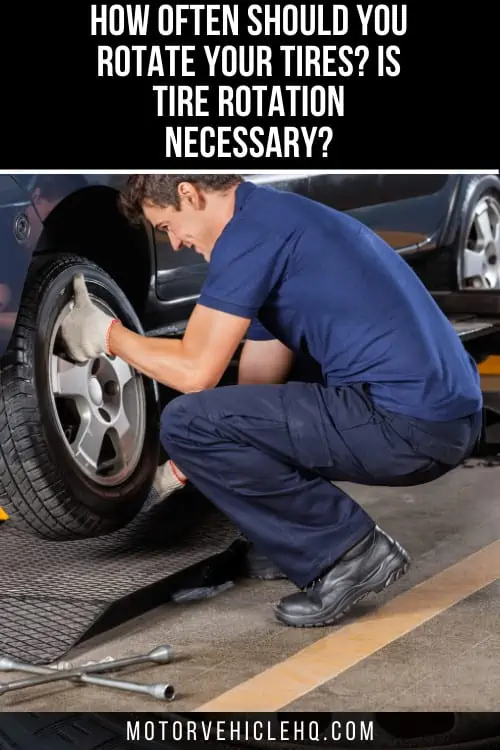

Nyangano Maurice specializes in vehicle troubleshooting and has more than 10 years of experience in the automobile industry. Over many years of experience as a car mechanic, he has acquired a broad range of skills, including engine repair, brake systems, electrical systems, and more. He frequently hosts community workshops and training programs to help motor vehicle owners understand their vehicles better.
